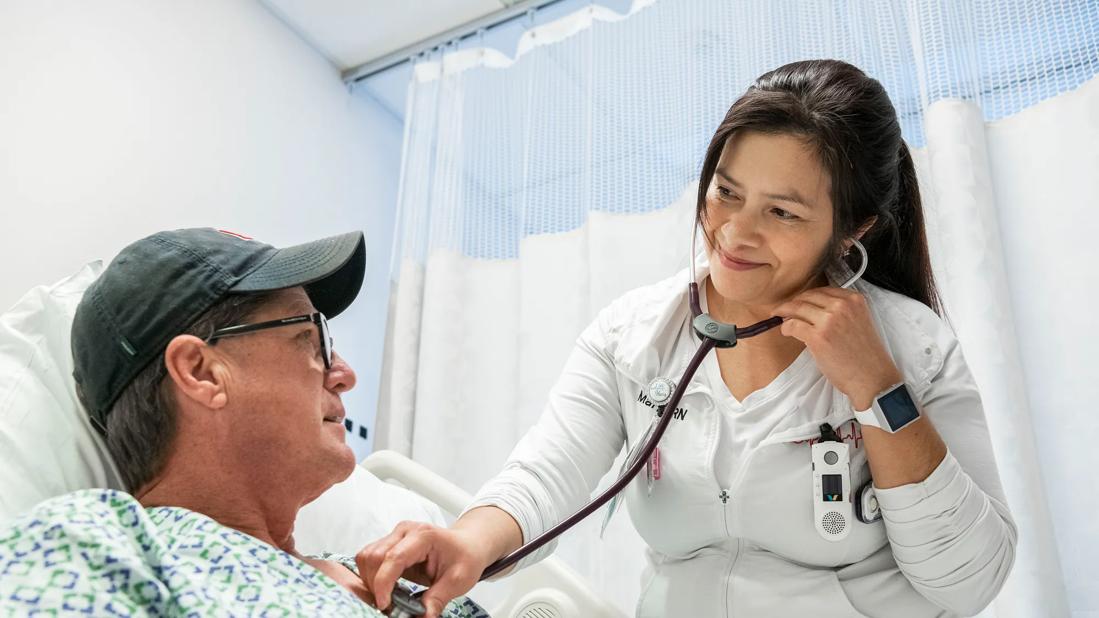Engaging the community in nursing education

Bedside handoff communication is a critical part of safe, quality patient care. In late 2019, Cleveland Clinic Marymount Hospital decided to do something novel for its bedside handoff education efforts – it enlisted the help of the community.
Advertisement
Cleveland Clinic is a non-profit academic medical center. Advertising on our site helps support our mission. We do not endorse non-Cleveland Clinic products or services. Policy
“We went to the source and invited our Health Care Partners (HCPs) to take part in our Bedside Handoff Initiative (BHI),” explains Meenakshi Gapa, MSN, RN, of the Office of Nursing Education and Professional Development at Marymount. “These partners are previous patients who volunteer on hospital committees and projects, providing feedback and input, from design to implementation, at Marymount.”
The effort was a collaboration between nurse managers on nine Medical/Surgical units and personnel from the Nursing Education and Patient Experience offices. Together, they collaborated to customize the initiative for their hospital, and requested involvement from the HCPs. The HCPs received training on acting as simulated patients and family members. Then, seven members of the Marymount HCP Council volunteered to come in during nursing shifts, where they were set up in mock patient rooms during scheduled time slots that started as early as 5:30 a.m.
“Our volunteers wore a hospital gown and lay in bed so our nurses could practice applying their bedside handoff check list,” explains Nurse Manager Cathy Schreiber, BSN, RN. “During simulations, staff were able to fully immerse in scenarios and connect to content, making it more meaningful and transferable to nursing practice.”
Gapa observed these mock handoffs and evaluated the nurses using an 18-step Bedside Handoff Checklist, which highlights what was achieved and opportunities for growth. Overall, there were three primary goals in conducting the simulations with HCPs on bedside handoff:
Advertisement
This effort also included educating the Patient Care Nursing Assistants (PCNAs). The nurses simulated sharing report, and the PCNAs simulated completing a Safety Rounds Handoff.
The scenario was modified for PCNAs, who were given handoff reports by the Educator to assume the role of the patient’s primary nurse. They would then complete their own PCNA-to-PCNA handoff activity following a 14-step Safety Rounding Checklist. “It’s crucial to include all parts of the nursing staff, because they are equally involved in patients’ care and experience during hospitalization,” says Gapa. “Empowering PCNAs to recognize how they contribute to patient safety is beneficial to all parties.”
Gapa notes that the nurses learned about:
The PCNAs learned about:
Gapa and Schreiber say the HCPs provided authentic exchanges and helped to organically create dialogues between staff, educators and volunteers. “Each community volunteer had a different history with us, and they brought genuine concerns, from repeat surgeries to having diabetes or hearing loss, and they took great care to provide us with useful feedback,” says Gapa.
Advertisement
“Our volunteers were very honest in their feedback, and they had a lot to say,” says Schreiber. “Our nurses learned, and it really opened up some very real conversations and a lot of laughter too.”
Gapa adds, “Our caregivers liked it so much more than expected! They are so used to working solely with Nursing Education personnel when involved in training. And as the educator, I had to let go of some control and let learning happen naturally.”
Medical/Surgical Nurse Tiffany Dotson, BSN, RN, says she appreciated an educational opportunity that featured hands-on training time with live patients. “Knowing that they were previous patients made the learning experience more impactful,” she notes.
Community volunteer Wendi Thumudo, said this about her experience, “I was able to act out some of the issues I’ve encountered over the years as a patient hospitalized for Crohn’s disease. It was wonderful to see how well trained the Cleveland Clinic staff is at spotting and correcting what could be potential life-threatening issues.”
With a goal of supporting patient-centered care and relationship-based care, this initiative widened Marymount’s focus and helped to strengthen engagement with the community. The initiative went from September to December of 2019, with 25 sessions on nine units encompassing four hospital floors. Other Cleveland Clinic hospitals are considering adding this process to their bedside handoff training.
Since 2009, Joint Commission National Patient Safety Goals have included Bedside Handoff as an important area to focus on to correct any patient misconceptions. This interaction is part of Cleveland Clinic’s ongoing education efforts for nursing caregivers.
Advertisement
Advertisement

Nurses harness cutting-edge technology as a bridge to healing

Project aims to improve patient care by streamlining caregiver transitions

Optimizing care while protecting patients from life-threatening reactions

Palliative nurses improve quality of life

Strong bonds and momentous milestones fuel life-changing work

Experts offer hands-on support and education

Special skills course aims to improve patient safety and comfort while building caregiver confidence

Bariatric nurses deliver sensitivity, compassion and skill